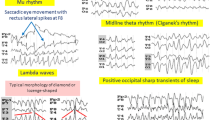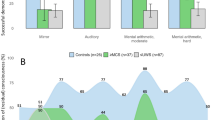Changes in the monoaminergic mechanisms in the brain at different terms after status epilepticus are determined by diverse causes and depend on the role of monoamines in the implementation of specific postictal rearrangements in CNS. Two mutually aggravating pathways cause disorders of monoaminergic mechanisms in the brain in 24 h after epileptic status: high spike-wave activity accompanied by hypocirculation that form a vicious circle; the resulting deficiency of monoamine consolidates the self-sustaining epileptic circuit. Increased activity of monoaminergic mechanisms in 5 days after epileptic status is a result of compensatory-restorative reorganization of neuronal networks and is not accompanied by spike-wave activity and hemodynamics disorders, but high convulsive readiness persists. Disturbances of monoaminergic mechanisms in 30 days after epileptic status prolong convulsive readiness that can serve as a pathogenetic basis for delayed cerebral disorders.
Similar content being viewed by others
References
Aronov DM, Lupanov VP. Functional Tests in Cardiology. Moscow, 2007. Russian.
Kryzhanovsky GN. The general theory of pathophysiological mechanisms of neurological and psychopathological syndromes. Zh. Nevrol. Psikhiatr. 2002;102(11):4-13. Russian.
Mamalyga ML, Mamalyga LM. Effect of Progressive Heart Failure on Cerebral Hemodynamics and Monoamine Metabolism in CNS. Bull. Exp. Biol. Med. 2017;163(3):307-312.
Semchenko VV, Stepanov SS, Bogolepov NN. Synaptic Plasticity of the Brain (Fundamental and Applied Aspects). Moscow, 2014. Russian.
Ahern TH, Javors MA, Eagles DA, Martillotti J, Mitchell HA, Liles LC, Weinshenker D. The effects of chronic norepinephrine transporter inactivation on seizure susceptibility in mice. Neuropsychopharmacology. 2006;31(4):730-738.
Erdoğan F, Gölgeli A, Arman F, Ersoy AO. The effects of pentylenetetrazole-induced status epilepticus on behavior, emotional memory, and learning in rats. Epilepsy Behav. 2004;5(3):388-393.
Fabene PF, Marzola P, Sbarbati A, Bentivoglio M. Magnetic resonance imaging of changes elicited by status epilepticus in the rat brain: diffusion-weighted and T2-weighted images, regional blood volume maps, and direct correlation with tissue and cell damage. Neuroimage. 2003;18(2):375-389.
Hitiris N, Mohanraj R, Norrie J, Brodie MJ. Mortality in epilepsy. Epilepsy Behav. 2007;10(3):363-376.
Jobe PC, Browning RA. The serotonergic and noradrenergic effects of antidepressant drugs are anticonvulsant, not procon-vulsant. Epilepsy Behav. 2005;7(4):602-619.
Logroscino G, Hesdorffer DC, Cascino G, Hauser WA, Coeytaux A, Galobardes B, Morabia A, Jallon P. Mortality after a first episode of status epilepticus in the United States and Europe. Epilepsia. 2005;46(Suppl. 11):46-48.
Maia GH, Brazete CS, Soares JI, Luz LL, Lukoyanov NV. Serotonin depletion increases seizure susceptibility and worsens neuropathological outcomes in kainate model of epilepsy. Brain Res. Bull. 2017;134:109-120.
Mainardi P, Leonardi A, Albano C. Potentiation of brain serotonin activity may inhibit seizures, especially in drug-resistant epilepsy. Med. Hypotheses. 2008;70(4):876-879.
Mamalyga ML. Cardiovascular Dysfunctions in Brain Disorders and Their Treatment. Saarbrücken, 2017.
Pitkänen A. Efficacy of current antiepileptics to prevent neurodegeneration in epilepsy models. Epilepsy Res. 2002;50(1-2):141-160.
Schachter SC. Vagal nerve stimulation. The Treatment of Epilepsy. Shorvon S, Perucca E, Engel Jr J. Hoboken, 2009. P. 1017-1023.
Author information
Authors and Affiliations
Corresponding author
Additional information
Translated from Byulleten’ Eksperimental’noi Biologii i Meditsiny, Vol. 167, No. 1, pp. 20-26, January, 2019
Rights and permissions
About this article
Cite this article
Mamalyga, M.L., Mamalyga, L.M. Role of Monoaminergic Systems of the CNS in Different Periods after Status Epilepticus and Its Relation to Cerebral Hemodynamics. Bull Exp Biol Med 167, 17–23 (2019). https://doi.org/10.1007/s10517-019-04451-x
Received:
Published:
Issue Date:
DOI: https://doi.org/10.1007/s10517-019-04451-x




